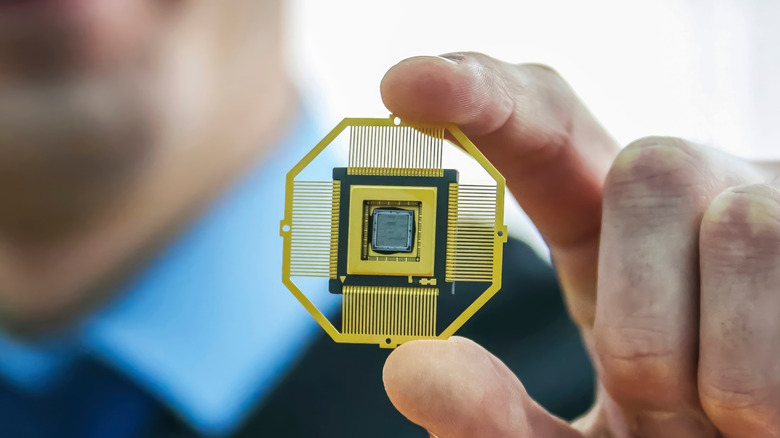What Is A System On A Chip (SoC), And What Is It Used For?
With every new smartphone release, the spotlight does not usually fall on the System on a Chip (SoC) powering the device. New and innovative features attract the most attention. It's only when the dust settles that general consumers start to notice what's the most important — the microchip system. An SoC is an integrated circuit that unifies and controls all the major components of an electronic system or device. To put it simply, it acts like the human brain, regulating all operations and ensuring that all functions are performed correctly.
Despite its small size, an SoC is considered a system because it consolidates different important components, including a central processing unit (CPU), graphics processing unit (GPU), memory, input/output ports, wireless connectivity modems like Wi-Fi and Bluetooth, and more recently, artificial intelligence (AI) hardware. The main goal of housing all these components in a compact packaging is to centralize processing and control functions, on top of reducing energy consumption and saving space inside the devices they power. This setup is different from traditional computing systems with separate chips or circuit boards for different functions and features.
SoCs are fabricated using semiconductor technology, and they rely on a single substrate (silicon) to embed their entire functionality. Such design streamlines communication between components and allows for faster data transfer, reduced latency, and improved power efficiency. This explains why Apple's M-series chips can deliver high-quality performance despite low power draw. The same can be said of the Snapdragon chips owned and made by Qualcomm.
What devices use SoCs to function?
SoCs are very important to many modern digital devices, especially those where space, energy efficiency, and cost-effectiveness are priorities during product development. Smartphones and tablets are the most common examples of this, with brands like Qualcomm (Snapdragon), Apple (A-series), and Samsung (Exynos) producing SoCs tailored to mobile performance. These microchips impressively handle everything, from basic processing to high-end gaming, camera image processing, and cellular connectivity. The compact design allows manufacturers to fit complex capabilities into small form factors.
Aside from mobile devices, SoCs are also integral to wearable devices such as smartwatches and fitness trackers, where hardware space is also extremely limited. Devices like the Apple Watch use custom SoCs (S-series) that combine processors, sensors, and wireless components in one chip to deliver powerful features in a tiny package. Smart home appliances, such as security cameras, smart speakers, and thermostats, also rely on SoCs for their efficient, always-on activity and whatnot.
In the automotive industry, SoCs are used in infotainment systems, digital dashboards, and, increasingly, autonomous driving features. NVIDIA's DRIVE series and Tesla's Full Self-Driving computer are notable examples. Many drones, gaming consoles, and Internet of Things (IoT) devices depend on SoCs for fast computation with low power use. Even computers, which used to only come equipped with motherboards, have made the switch. Aside from Apple's MacBook M models, several computers, like Microsoft's Copilot+ PCs, are now powered by SoCs. The switch allows their manufacturers to come up with thinner and lighter designs.
Why computers might not use SoCs
While SoCs dominate the territory of compact electronics and mobile devices, traditional desktop computers and many laptops — especially the non-slim designs — still use conventional hardware architecture, primarily because of their need for flexibility, higher power capabilities, and expandability. Computers usually utilize separate components, like a CPU, GPU, RAM, and storage, which are individually installed on a motherboard. This modular design allows users to upgrade or replace parts, a key advantage for tasks requiring high performance, such as gaming, video editing, 3D rendering, and scientific computation. Notice how SoC-powered laptops have limitations when handling highly intensive games and other programs and software.
Many computer manufacturers still prefer motherboards over SoCs because the latter is not designed for sustained workloads, large caches, and high bandwidth memory. All of which are easier to implement with traditional computing systems. For instance, high-end GPUs like NVIDIA's RTX 5090 or AMD's Radeon RX 9070 series are too big and power-intensive to be integrated into an SoC. Additionally, workstations and servers require scalability and multi-component architectures to be able to handle massive processing tasks simultaneously — something SoCs can't really handle. As such, data center PCs still rely on Intel and AMD CPUs with separate GPUs and RAM, following the traditional motherboard layout. However, it's possible for SoCs to penetrate the data center sector soon as more advancements in the technology are made and as the industry itself starts to recognize the potential of microchips in optimizing the performance of data center computers.


